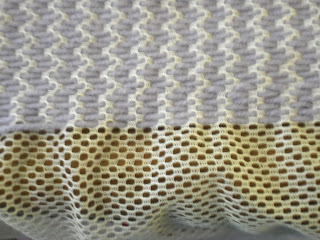I've woven most of this afghan with one needle. I tried using two at a time and it worked pretty well. So I dug deep and found, not one, not three, but eight needles. Using them all at once would finish a whole inch in one pass across the afghan.
I've done this weaving before, but I'm doing some experimenting this time around. Let me tell you that this particular experiment was less than a glowing success!
I had trouble moving each needle from one side to the other of the table without dropping one or more other needles off the edge. The yarn was not cooperative as you will see shortly.
Which I pulled out and rewove working between the other strands already in place.
I did figure out an easy way to keep the needles organized. You stick the point into the fabric in the correct order. Then you know which one to use next as you work across and they don't fall off the edge of the table.
Thanks for visiting with me,
Kathi Linz
P.S. Three needles is do-able. After that, you have to be very careful.
I've done this weaving before, but I'm doing some experimenting this time around. Let me tell you that this particular experiment was less than a glowing success!
I had trouble moving each needle from one side to the other of the table without dropping one or more other needles off the edge. The yarn was not cooperative as you will see shortly.
I discovered that it is much easier to make a mistake than it would be with a single strand at a time.
Which I pulled out and rewove working between the other strands already in place.
I did figure out an easy way to keep the needles organized. You stick the point into the fabric in the correct order. Then you know which one to use next as you work across and they don't fall off the edge of the table.
I think I will stick to using fewer needles from now on.Thanks for visiting with me,
Kathi Linz
P.S. Three needles is do-able. After that, you have to be very careful.






































